House Diary: Litha
[Cover Photo: My own personal Stonehenge – the rays of the rising sun illuminate its coppery representation on my living room wall for just the few days surrounding summer solstice]
Litha is the pagan term for summer solstice, the longest day of the year (or thereabouts) in the northern hemisphere. Ancient Stonehenge is set to catch the rising sun’s rays on this date, which was once celebrated with considerably more panoply than today. Also known as Midsummer (based on the old agricultural calendar, which divided the year into just two seasons, light and dark, starting with the equinoxes), Litha was commonly observed with the burning of huge bonfires to celebrate the sun at the peak of its maximum, life-giving strength.
It’s been a dry spring here at the house, but relatively cool. Now as Litha and the summer season commences, the temps are rising, but it’s just as dry as ever. Not a good combo for yours truly, who feels like some botanical version of Gunga Din, lugging gallons of water daily to keep my precious plant babies alive. But last night some drenching thunderstorms doused the garden, so I’m taking a much-needed morning off to compose this diary entry.
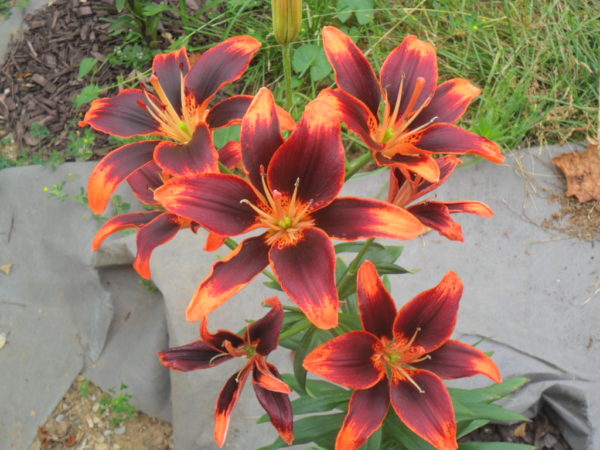
One of the new “Forever Susan” Asiatic lilies in full bloom; the dramatic coloring makes it a welcome addition to the landscape, with individual blooms lasting up to a week
It’s been a busy six weeks since Beltane. The mail-ordered perennials came in two batches, which was as well for me, as managing all 70 at once would have been quite a trial. By and large, however, these have been disappointing in their performance, with lots of no-shows from the early arrivals, despite tender loving care as they adjusted to their new surroundings. Among those absent, all the heucheras, five out of six of the Asiatic lilies, all the bee balm, and both black hollyhocks. I had especially been looking forward to the latter, but that’s gardening life. It’s been almost six weeks since planting, so if they haven’t come by now, they likely won’t. Hopefully the second group, planted just last week, will fare better.

“Pink Giant” Asiatic lily flowers next, on tall elegant spikes with downturned blossoms; I can’t wait until the plant matures enough to offer several such spikes
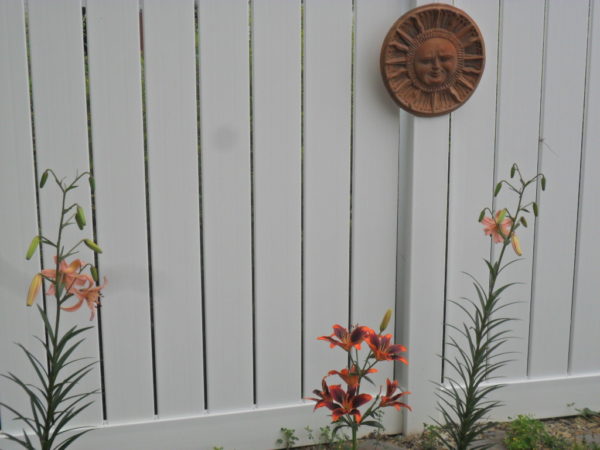
A wide shot of a mixed stand of lilies, showing the height difference between Forever Susan and Pink Giant, as old Sol looks on
Fortunately the echinacea, or coneflowers, have made a brave showing, with 8 of 10 up and thriving. These come in a wide array of colors, white through orange and red, which I supplemented with some traditional purple coneflowers from the abandoned wildflower garden my father carved out of the fallow field across the property line, now owned by somebody else.
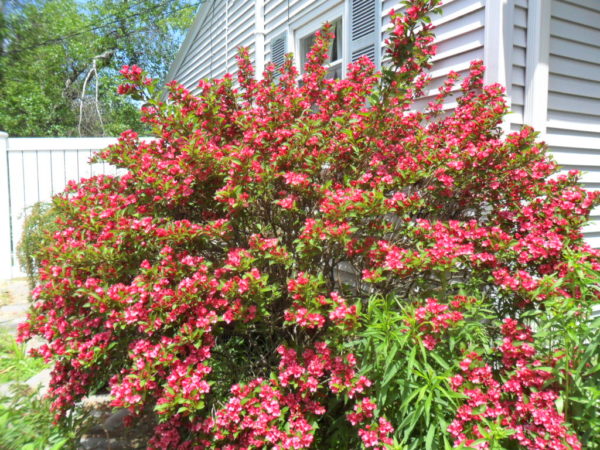
This weigela has been on the property as long as I can remember, and typically blooms over Memorial Day, though the cold spring gave it a late start this year
(Yes, the curse has come upon me, with a new house being built directly behind mine. Thank goddess for that new fence! At least when I’m in the garden, I can still pretend there’s no one back there. And technically, there isn’t, yet. The house is in the earliest stages of construction, but once the new owners move in, I’ll introduce myself and suggest we go halfsies on a nice row of privacy-providing, quick-growing pines along the property line.)
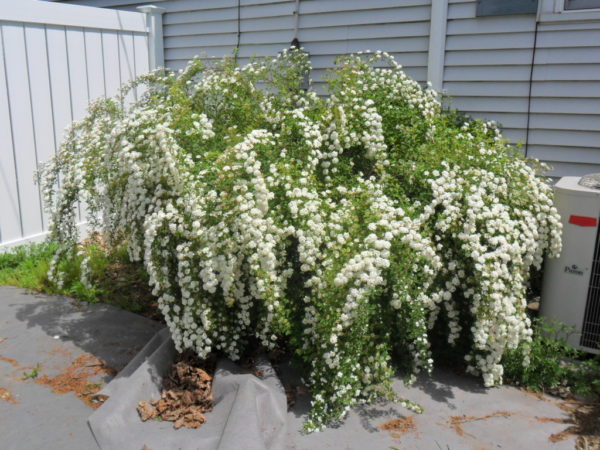
The massive bridal wreath just starting to bloom; you can’t see him, but Charcoal is resting beneath it, keeping a watchful eye for mice and birds
But to return to the matter at hand. Last autumn’s installation of lilies is beginning to pay off. All but one of the four dozen planted have returned, and the show is starting! First is an Asiatic lily called “Forever Susan.” It’s a stunning mix of orange and purple-black, with long-lived blooms that are erect and upward-facing, and endure up to a full week before fading. I thought perhaps I was over-buying with 10, but now they’re up and doing, I’m very glad I did. As these mature over the next few years they will provide a reliable and sensational focal spot, at least for the 3 weeks or so that they’re in bloom.
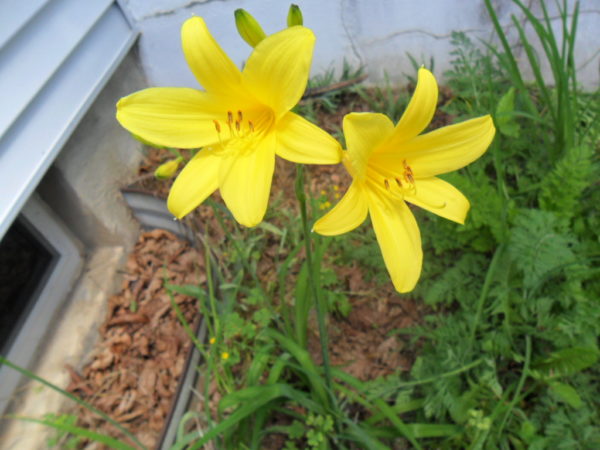
My mother planted these lemon lilies when I was a toddler, a division taken from her mother’s garden; changing shade patterns mean they have thinned over the years, and I will need to move them this fall to ensure they don’t die out

If the lemon lilies are failing, the fire lilies are abundant; last autumn we made 8 divisions which are now thriving all over the garden
Another good performer is Pink Giant, a tiger style lily, with downturned blossoms, tinted a pale pink speckled with mauve. As the name implies, it’s a larger flower, on taller stalks, and again, all three in my possession are blooming prolifically. Two more varieties have yet to show their stuff, though one, Stargazer, I’m already familiar with from a plant my mother had for decades. Rosy pink with white trim and mottled in brown, two of my three are struggling and don’t look like booming this year, though the third is thriving and set with a half dozen buds.
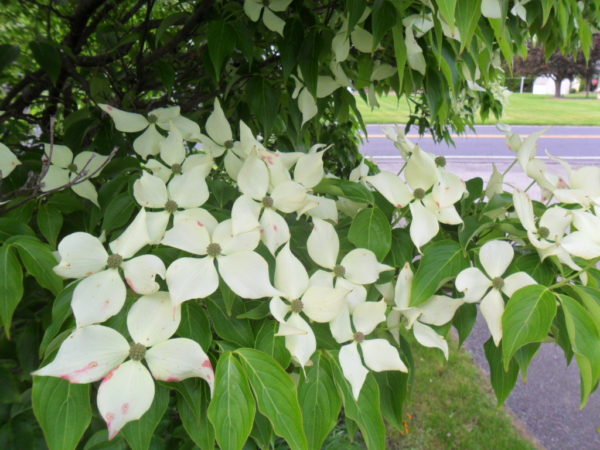
The Chinese dogwood in the front yard was thick with white blossoms; these bloom much later than native varieties, lighting up the June landscape
The daylilies will come in soon; some are already thrusting green canes skyward. Actually, the first crop is already over – lemon lilies, which have been here since I was a child. These bloom early enough to be included with peonies and iris in bouquets. Their bright yellow blossoms last only a day, but brighten the late May garden, which can be a little lackluster as early spring entrants have passed and later-flowering perennials are still in their first growth phases, just starting to set buds for bloom.
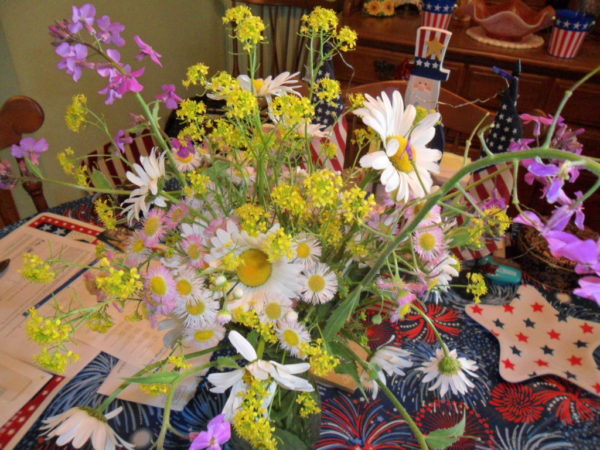
My Memorial Day bouquet this year was a composition of wildflowers, since the elements of my traditional “red, white & blue” bouquet were not yet in bloom, delayed by the cold spring; here rocket, daisy and fleabane vie with a yellow weed I’m unfamiliar with (but which is ubiquitous in the garden this year), which acts as a baby’s breath-style unifier
Late May is also the time for flowering shrubs, and I have a well-established bridal wreath and weigela on the property; both date from the earliest days of the homestead. There is also a large Chinese dogwood in the front yard, which blooms in June, much later than the standard varieties. One of my Philly stray cat transplants, Charcoal, likes to snuggle under the vast umbrella of the bridal wreath’s pendulous branches, so heavy with tufts of white blossoms they scrape the ground when the plant is in full bloom. From his spacious green-clothed cavern, Charkey reigns supreme o’er all he espies (without being seen himself).

The living room at Litha; I focused this year on the “stars & stripes” collection, as opposed to summer florals, allowing me to preview the setting for the major collections to go on display this fall and winter
Mid-May is the time to put up the summer decorations, and I start with pieces from my extensive “Stars and Stripes” collection, which I leave on display through July 4th into early August. And of course there’s the summer faux florals, including roses, geraniums, daisies and sunflowers; as well as shells, evocative of summer vacations at the shore; suns in all types and styles, for the solstice; and later towards Lammas I add bees, corn, and wheat, all emblematic of that season. (And if an early scarecrow should make an appearance at Lammas, what of it?) This year I’m also putting out a collection of feathered fowl in honor of my parents’ love of birding, but over all I’m still in ‘skeleton crew’ mode, with barely a third of the summer collection on display as I work toward adapting the new space to my needs.

Just a tithe of the Uncle Sams in the collection; my favorite, an egg-shaped shelf-sitter which I term the “Humpty Dumpty Sam”. is still packed away in a box somewhere … I hope
With Memorial Day so early this year, and the cold spring delaying usual bloom times, unfortunately I was unable to decorate the table with my traditional “red, white and blue” bouquet, which I have made since I was a kid, composed of English daisies, blue Siberian iris, and branches of red weigela. I made one up a week or so later, but it wasn’t the same when my cousin came for our two-person, COVID-restricted outdoor lunch on the holiday.
Something else I miss from my childhood is the bloom of locust trees; my grandmother’s backyard was awash with them – ancient, hoary and yet delicate with their spiny leaf fronds trimmed by small oval leaves. Their clustered white blossoms were always in full swing as the extended family gathered there for our Memorial Day picnic, with some spent blooms drifting down onto the platters and bowls of food laid out on old metal folding tables.

The door from the kitchen to the garden is appropriately decked with daisies and insects, previewing the wonders beyond it; lunar lights mimic the firefly lights interspersed; year-round, the head of Dionysos guards the entrance to my own private wildwood
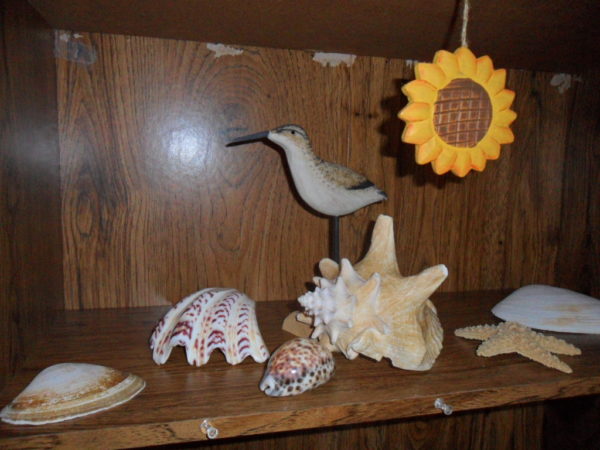
A wooden sandpiper from my parents’ bird collection seems quite at home in this scattering of seas shells, evocative of summer vacations at the shore; most were gathered by my folks
My grandmother’s sisters, their children and grandchildren would attend these feasts, which seemed to go from dawn to dusk and often started with breakfast cooked over the old wood-fired brick stove at the bottom of the yard. If you’ve never had bacon, scrambled eggs and home-fried potatoes cooked outdoors, I highly recommend it as an experience not to be missed. Nana went through a lot of wood on those days, with breakfast followed by hot dogs and hamburgers mid-afternoon, barbecued chicken for supper, and marshmallows roasted over the embers in the evening, as bats flit overhead between the trees. Everybody brought a side dish or a dessert; I still make my great-aunt Marion’s chocolate cupcakes with cream cheese filling, though being as over-the-top culinarily as I am, I have to gild these pastry lilies with peanut butter icing. And I can still taste my great-aunt Anna’s baked white lima beans, sweet but also tomato-spicy from her Italian heritage, though sadly, the recipe for these died with her in the early ‘90s.

My grandmother at her usual station on a summer holiday, manning the old brick wood-fired stove in the backyard; she’s really not as cranky as she looks in this picture, but you’d be out of sorts, too, if you just fried hamburgers for 25 hungry relatives in 90 degree heat over an open fire!
Meanwhile, back at the ranch, I also inherited a large number of flame lilies, deep red-orange, which we split and randomized about the garden last fall. These are well established and will provide weeks of color as July deepens. The new arrivals are dyed in tones of pink, gold, cream, wine and burgundy, with dramatic striping or throats, and some have already started shooting buds above their leafy mounds, though it will be several seasons before they’re established enough to put on a real show. These are the so-called “reblooming” daylilies, first I’ve tried, which supposedly will flower sporadically all summer long, not just for a few weeks in July or August. We’ll see …

The patriotic serving-ware is still packed away, but this image of a July 4th “picnic” at the old apartment gives an idea of the visual (and culinary) delights that await next year’s guests; among the entrants – seven layer salad, deviled eggs, baked beans, assorted pickles, potato salad and pulled pork barbecue. Look closely and you’ll see my girl Ashes on the stair landing upper right, a black silhouette with glowing eyes
My main focus this month has been the shady areas under the birches. When the bareroot heucheras failed to sprout, I bit the bullet and went for live plants at my favorite local nursery, Point Phillips Perennials, a great source for hard-to-find shade lovers. Live plants of this size and quality can be pricey, but it’s only money, right? I picked up a hardy geranium, with delicate deep pink blossoms and a lovely red foliage in the autumn, a few heucheras in assorted shades, a toad lily, multiple woodruff, and a brunnera. Supplemented with some of my Philly hostas and ferns, and a few new hostas from other garden centers, there’s now a thriving community of shady characters.

The area under the birch has been my focus for planting this year, with new perennials plunked into the soil at regular intervals, allowing space for expansion; the reclining doe statue was my grandmother’s and has now returned to this property after its extended thirty-year tour of Philadelphia
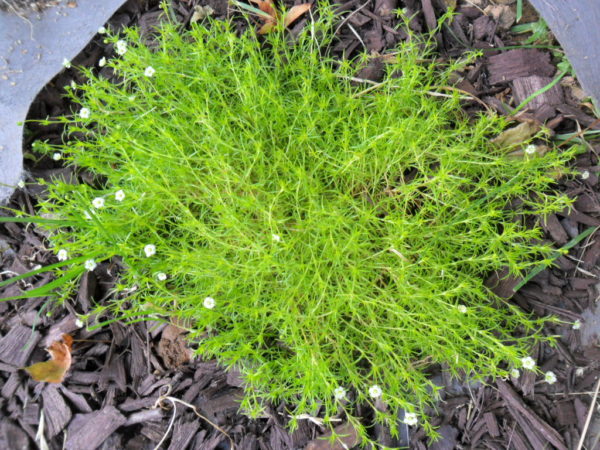
A close-up of one of the plugs of Irish moss, which has a gorgeous lime color and sports the teeniest blossoms you’ve ever seen, emerging randomly throughout the growing season
I also ordered some bleeding heart bareroots, which came in the second batch and were planted last week. Of course, you know me well enough by now to suspect that the standard pink bleeding heart was not gonna cut it for Alex’ garden! And you’d be right. I acquired two more exotic species – “Burning Hearts”, which is two-toned, rosy red with white trim and blue-gray foliage; and “White Gold”, with white blossoms and chartreuse leaves. I am thrilled to report that 4 of 5 plants are already up, though the delay in planting inclines me to think they may not bloom this year (ordinarily by late June bleeding hearts are beginning to die back). I’m not big on delayed gratification, but I’ll happily wait for these beauties to show their stuff so long as they’re healthy.
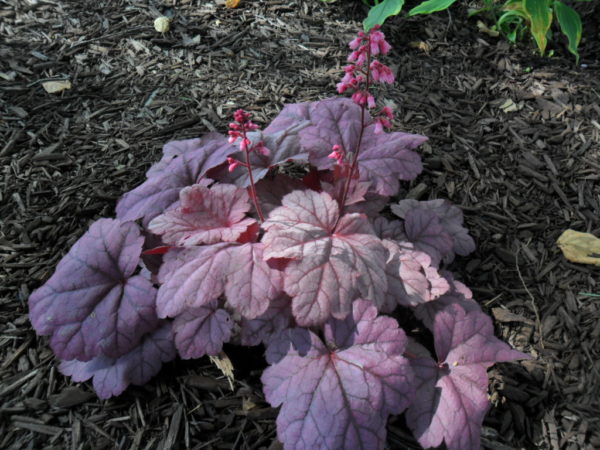
A purple heuchera adds vibrant color to the shade garden; note how its teeny florets on the spikes match the foliage hue, a common phenomenon for heuchera
At Point Phillips I also acquired a ground cover I haven’t heard of before, mazus reptans. It spreads rapidly, has a diminutive leaf on trailing vines which mat over time, and in the spring a lovely orchid violet blossom. It tolerates any light level, though it blooms best with some sun, so I divided the block flat into 12 and distributed them throughout the garden to see where they like it best. What I like best is that, like Irish moss, which I also planted, it tolerates foot traffic.
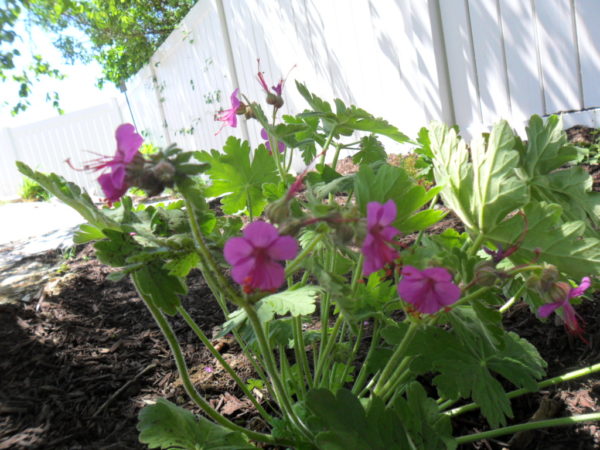
A new hardy geranium loves shade, and promises year after year of brilliant bloom and stunning fall color, as the foliage reddens; it also spreads readily
I couldn’t resist picking up some sunny perennials as well, and I now have a decent assortment of coreopsis, which is drought tolerant and doesn’t need as much care; and catmint, a new one for me, with grey-green foliage and spikes of blue lavender blossoms. I’m especially fond of the new Tickseed coreopsis, brilliant yellow with vivid burnt red bands. I had grabbed half a dozen heliopsis on an earlier trip to Point Phillip Perennials, including two new varieties, both with reddish-purple foliage. One, “Fire Twister”, has already started to bloom, vivid red-orange blossoms which fade to rusty tangerine, making it a prized new addition to the garden. Along with the Brown-eyed Susan hybrids which were already on the property and some purple bee balm I brought with me from Philly, the sand mound is beginning to fill in nicely.

A tickseed waves cheerily from the perennial border along the grass path, just one of a wide variety of coreopsis scattered throughout the garden, along with double coreopsis, pictured below
For a pop of quick color, I bought annuals to line the pathways. The bronze-leafed wax begonias, white- and pink-flowered varieties, are holding their own, but the magenta and salmon verbena are burning out in the sun; no amount of water seems to help. However, the portulacas are thriving; a succulent relative, these are also drought tolerant, and the pink mix I purchased is blooming prolifically, though the flowers themselves only last about a day, and won’t open at all if skies are cloudy. It takes time and patience to find what does best in a new garden, and I’m very happy to have found these so adaptable to my conditions – no doubt, portulaca will be on my list every year!
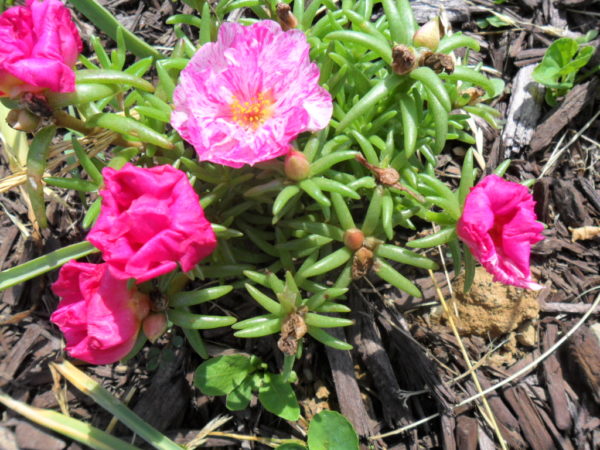
Portulaca is a reliable annual which is sun-loving and drought tolerant, making it a perfect overplanting for the small spring bulb border on the sand mound; a perennial here would eventually inhibit the bulbs’ emergence as its root mass thickens
Inside, I’m still unpacking. When will it end? Actually, most of the living space is unpacked now, when I finished the kitchen boxes last week. It’s mainly stored things in the laundry and basement, seasonal decorations and the like, which still need organizing and redistribution. But since the local thrift store remains closed due to coronavirus, the boxes of donations are piling up in the garage.
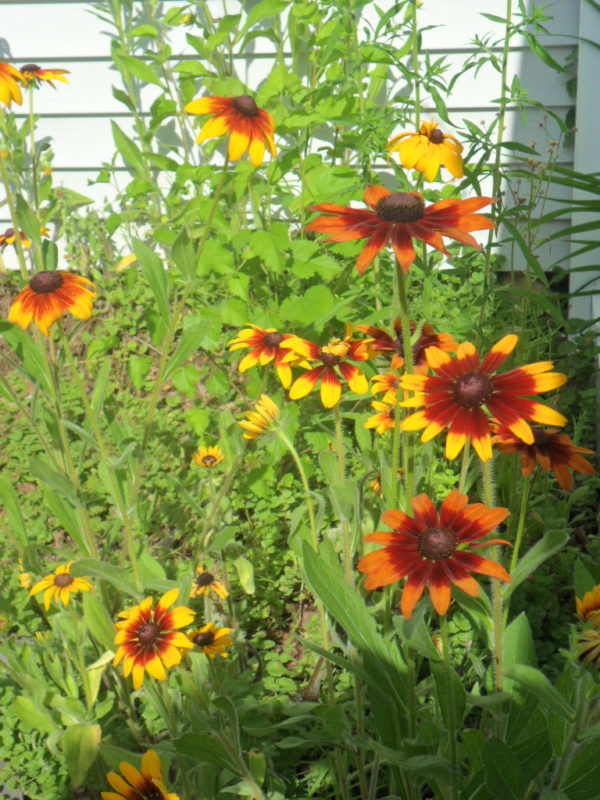
A patch of self-sown brown-eyed Susans; they started here decades ago as common yellow rudbeckias (right, rear), but over the years have cross-bred with wildflowers, and now bloom in a dizzying variety of colors, banded in tones from brick to brown
And I have a couple of projects I’m working on. My father, an avid hunter, left a stunning whitetail deer head, of a beautiful 7-point buck, as well as a mounted black squirrel and ruffed grouse, and an assortment of unmounted antlers with skull caps. I decided to keep these and dedicate one wall of the office to his hobby, so as soon as Michael’s Crafts was open for browsing again, I went in and picked up some small wood plaques to mount these, along with paint and hangers. I hope within a few weeks to have them ready for display, and plan to ring them in a semicircle around the full head, along with the enlarged photo of the elk that gored him in 2005 (an avid photographer as well as hunter, my father got too close to a male during the rutting season, and paid the price for this photo, which has hung on his wall ever since).
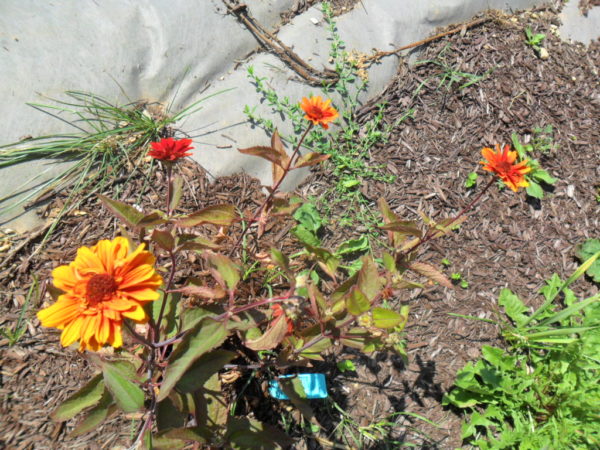
“Fire Twister” is the latest heliopsis cultivar – unlike the bright yellow it is bred from, these flowers emerge deep orange-red and fade through rusty tangerine to an almost pastel ochre
Lastly, I was finally able to obtain a few dwarf evergreens to my liking, for the area of the Stray Cat Shrine. I went for a dramatic contrast: compact mugo pine, with its whorled mounds of spiky emerald needles, like some coniferous nautilus; and a lime-yellow, airy chamaecyparis (false cypress). These now triangulate the cat statue, with a blue-green boxwood off to one side. I haven’t yet decided on bulbs or annuals to underplant the area, but it’s a good start!
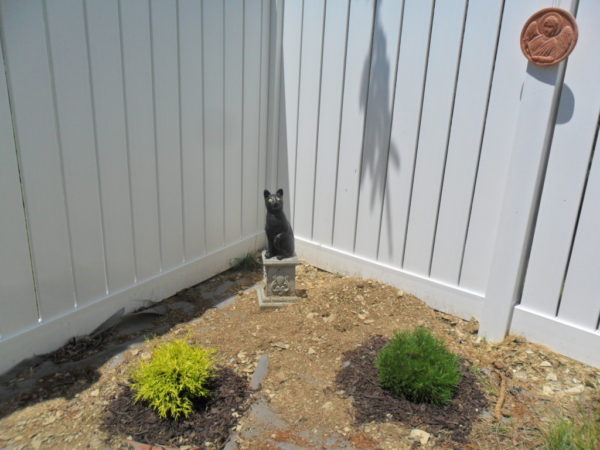
The Stray Cat Shrine in the northwest corner is beginning to take shape, with a couple dwarf evergreens and a Guardian Angel plaque
It’s looking like a long hot summer of watering, weeding, and pampering plants; I’m already pining for October!

Stop the presses! This purple daylily first flowered the morning of publication of this article, hinting at summer glories to follow

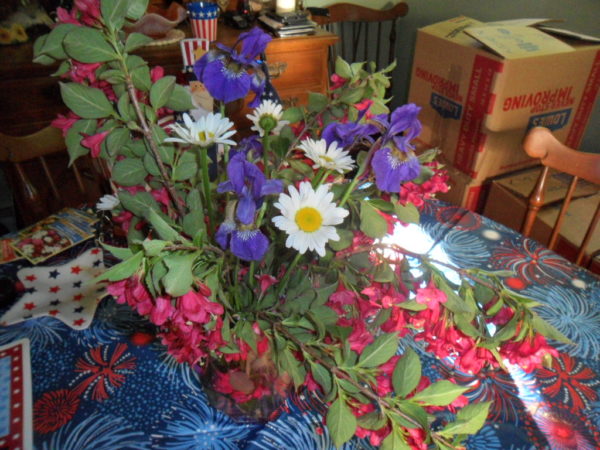
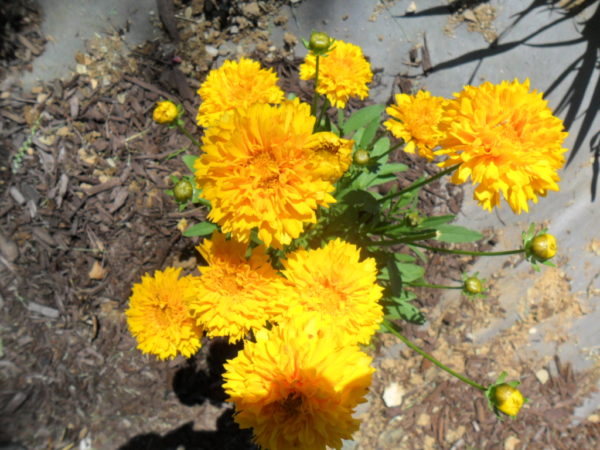

2 comments, add yours.
Alexa
Hi Alex,
The garden flowers are looking great, very colorful! Your labors are paying dividends.
I love your patriotic collection. Happy 4th of July to you!
edna
Your garden puts mine to shame! Love your decorations, too. Thanks for sharing your garden paradise in a virtual desert.